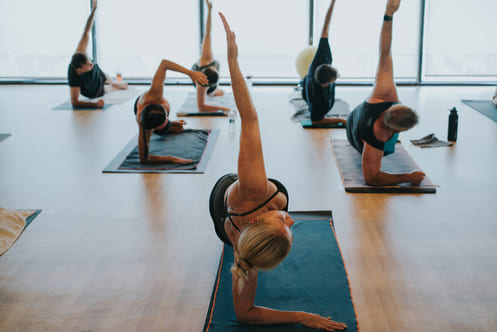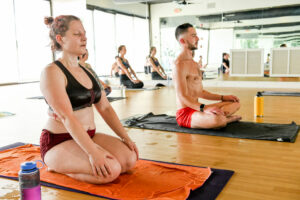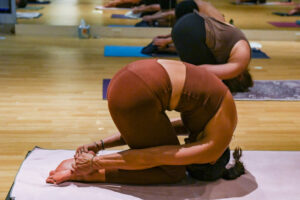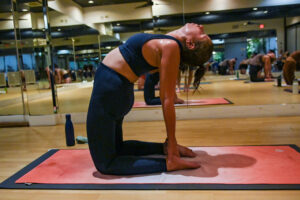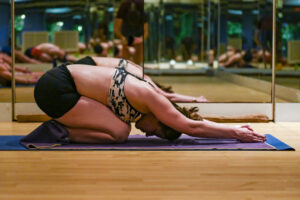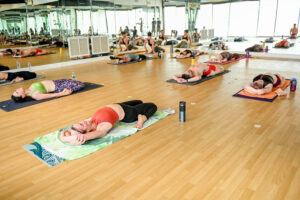Dandayamana Bibhaktapada Janushirasana, or Standing Separate Head to Knee Pose, may feel like you’re in a spontaneous game of Twister on your yoga mat, but your body is actually working on stretching and strengthening. This posture, along with others, is about exploring your mind, body, and spirit. It’s perfectly okay if you can’t get the pose ‘right’ the first time, or even the tenth time. Each time you step on your mat, you learn a little more about yourself and your abilities.
Before diving in, here is what we will cover in this article:
Bikram Yoga
Step by Step Instructions
Modifications
Benefits
FAQs
Bikram Yoga
Bikram Yoga is a holistic practice, designed to work every part of the body. The practice takes us through a sequence of 26 yoga poses. At YogaSol, we practice Bikram Yoga in a room heated between 103 and 108 degrees Fahrenheit with about 60% humidity. The heat serves a practical purpose by warming up our muscles, which increases flexibility and reduces the risk of injury. Subsequently, it also increases the sweat factor quite a bit!
If you’re new to hot yoga, the heat and humidity might feel intense at first. Eventually, you’ll notice that your body gets used to the temperature, and you’ll experience the benefits that come with it. Don’t forget to drink lots of water before, during and after class.
How to Practice Standing Head to Knee Pose (step by step)
Standing Separate Head to Knee Pose, from the ancient language of Sanskrit, Dandayamana Bibhaktapada Janushirasana translates to “Standing Separate Leg Head to Knee Pose”. This asana (meaning posture) is traditionally practiced in the middle of the Bikram Yoga sequence and is the tenth pose out of 26. Although it appears simple, it is important to work through the posture carefully to avoid injury.
Here’s how to practice this pose, step by step:
- Start Standing Tall: Begin standing on your mat, feet together, shoulders relaxed, and breath steady.
- Space for Movement: Step or lightly jump your feet about hip distance apart. Create space in your body and establish a firm base.
- Raise Your Arms: Inhale as you raise your arms to shoulder height, parallel to the floor, palms facing down.
- Bow Forward: Exhale as you bow forward from your hips (not your waist). Lead with your chest and keep your back straight. Allow your hands to reach toward your toes.
- Find Your Toes: If you can, reach for your toes. Hold onto your shins or ankles if you can’t reach your toes. Remember, the aim isn’t to force or strain. Find a position that feels challenging yet accessible for you.
- Create Connection: Inhale and lengthen your spine, while looking forward. As you exhale, bend your elbows wide to the sides, and gently pull your body closer towards your legs.
- Rest Your Head: Try to rest your forehead on your shins. If this isn’t possible yet, don’t worry. With time and practice, flexibility will increase.
- Focus on Breathing: Hold the pose for a few breaths or as long as it feels comfortable. Each inhale should lengthen your spine, and each exhale should help you fold a bit deeper.
- Gently Release: Lastly, when you’re ready, release your toes and slowly roll up to a standing position, letting your head come up last.
The goal of this pose isn’t to make your head touch your knee instantly; it’s more about finding a comfortable stretch and maintaining stability. As a result, over time and with practice, your flexibility and ability to compress will increase.
Modifications
Always listen to your body and move with your breath. This pose is a journey, not a destination, so be patient with your progress.
Limited Hamstring Flexibility: If touching the floor seems out of reach, it’s perfectly acceptable to rest your hands on your shins or knees instead. As your flexibility increases with consistent practice, you can gradually work your way toward the ground.
Back Issues: Individuals with lower back issues should be particularly careful when performing this pose to avoid strain. Maintaining a slight bend in the knees can alleviate pressure on the lower back. Additionally, focusing on maintaining a flat back when bending forward (hinging from the hips) is crucial.
Balance Challenges: If you’re finding it challenging to balance, try practicing the pose near a wall. You can lightly rest a hand on the wall to help stabilize you as you get comfortable with the pose.
Neck Strain: If looking up at the ceiling causes discomfort in your neck, feel free to keep your gaze forward or slightly downwards.
Mind and Body Benefits
The Standing Separate Head to Knee Pose is a full-body exercise. All of our main muscles – from our arms and shoulders, all the way down to our legs and feet are worked. You may notice a stretch in your hamstrings, hips, and back. This pose also improves your balance and coordination, which are important skills for your everyday life.
When we practice this pose, we focus on our alignment, our breath and the sensations in our body. With practice, our ability to focus in our day-to-day lives can improve.
Yoga is also a wonderful tool for managing stress. We practice staying present in our practice, rather than letting our minds race ahead to future worries, which is something that we can take into our everyday lives.
Deep, mindful breathing is also very beneficial to our minds and bodies. We tend to breathe more shallowly when we’re stressed, but yoga encourages us to breathe deeply and bring awareness to our breath. Practicing deep, rhythmic breathing can help to calm the nervous system and help to manage stress and anxiety.
Five Tips for Your Bikram Yoga Journey
If you’re new to Bikram yoga and are feeling a bit nervous or overwhelmed about starting your practice, we are here for you. Here are a few pointers to help you out:
- Ease into it: You wouldn’t sprint full speed without a warm-up, right? The same goes for yoga. Use any modifications for poses that feel right for your body, and with practice, you’ll notice your strength, flexibility, and balance all improve.
- Tune into your body: Your body’s smarter than you might give it credit for. It’ll tell you if you’re pushing too hard. If a pose doesn’t feel right, ease off a bit. Breathe and relax into it.
- Be in the moment: Focus on your breath. Feel the sensation of every stretch.
- Show up, again and again: Consistency is your best friend. The more time you spend on your mat, the more familiar you become with your body, and the more you’ll grow in your practice.
- Consider joining classes at YogaSol: Being in a class environment is a great way to improve your practice in a safe and welcoming community environment.
Remember, your yoga practice is your own. It’s not about perfection. Above all, take your time, be patient, and keep showing up for yourself.
FAQs for the Standing Head to Knee Pose
What if my balance isn’t good enough for this pose?
You’re not expected to achieve perfect balance right away. Balance, like any other skill, takes time and practice to develop. You might wobble or even fall out of the pose at first – and that’s okay. Each time you try, you’re building strength, enhancing your focus, and improving your stability. As you continue to practice this pose, you will notice gradual improvements in your balance.
What if I’m not able to do all 26 Bikram Yoga Poses?
It’s perfectly normal to feel a bit overwhelmed when you are new to Bikram Yoga. However, keep in mind there’s no requirement to perform all the poses perfectly, or even at all. Yoga encourages us to respect our bodies and our different abilities. Some days, certain poses might feel easier, and on others, more challenging.
Will I be the least experienced person in the room?
At YogaSol we celebrate all levels of experience as each stage brings its own learnings and challenges. It’s perfectly fine to be a beginner – every master was once a beginner too. Remember that each person in the room is focusing on their own practice, just as you are on yours. So, take a deep breath, focus on your own mat, and keep showing up for yourself.
I’m not very good at focusing, what if I can’t stay present?
You’re not alone – staying present and focused is something that many of us struggle with. Staying present in our practice takes practice! When your mind wanders during the Standing Separate Head to Knee Pose or any other pose, remember that it’s not a failure. Notice your thoughts, then guide your focus back to your breath. With time and practice, you’ll notice staying with your breath gets easier, not just in your yoga practice, but in your everyday life too.
 -ing our NEW! Community Classes!
-ing our NEW! Community Classes!
